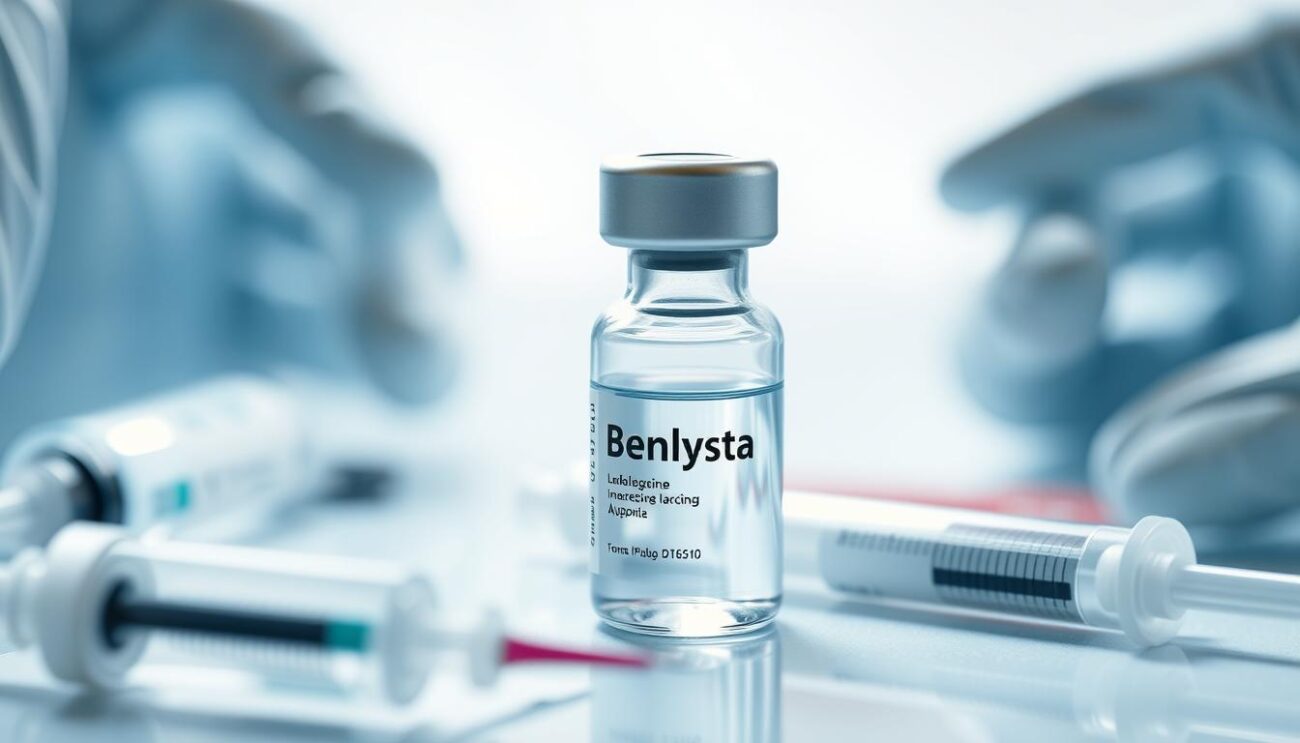Have you been prescribed the autoimmune medication Benlysta (belimumab) to manage your systemic lupus erythematosus (SLE) or lupus nephritis? While Benlysta can be an effective treatment, it’s crucial to understand the potential side effects of Benlysta to ensure your safety and well-being throughout your treatment journey. What are the serious risks associated with this medication, and who should exercise caution when taking Benlysta? Dive in to find the answers and make informed decisions about your lupus management.
Key Takeaways
- Benlysta can cause serious side effects, including infections, allergic reactions, and mental health problems.
- Patients should be aware of the potential risks associated with Benlysta to ensure proper use and monitoring during treatment.
- Certain individuals, such as those with a history of cancer, depression, or weak immune systems, may be more susceptible to Benlysta’s side effects.
- Proper dosage, administration, and storage of Benlysta are important to minimize the risk of adverse reactions.
- Regular monitoring and follow-up with healthcare providers are crucial for managing Benlysta side effects and ensuring the medication’s safe and effective use.
Serious Side Effects of Benlysta
While Benlysta, a medication used to treat systemic lupus erythematosus, can provide significant benefits, it is also associated with some serious side effects that patients should be aware of. These include infections, allergic reactions, and mental health problems.
Infections
Benlysta can increase the risk of serious infections, such as pneumonia, urinary tract infections, cellulitis, and bronchitis. Patients should be vigilant for signs of infection, including fever, chills, pain or burning with urination, coughing up mucus, or warm, red, or painful skin or sores. Prompt medical attention is necessary if any symptoms of infection develop, as serious infections can lead to hospitalization or, in rare cases, even death.
Allergic Reactions
Serious allergic (hypersensitivity) reactions can occur with Benlysta, either on the day of infusion or in the days after. These reactions can be life-threatening and may cause death. Symptoms of an allergic reaction can include itching, swelling of the face, lips, mouth, tongue, or throat, trouble breathing, low blood pressure, dizziness or fainting, headache, nausea, or skin rash. Patients receiving Benlysta through an intravenous infusion will be closely monitored for signs of an allergic reaction.
Mental Health Problems and Suicide Risk
Benlysta can also cause mental health problems, including thoughts of suicide or dying, attempted suicide, trouble sleeping, new or worsening anxiety or depression, and other unusual changes in behavior or mood. Patients should inform their healthcare provider immediately if they experience any of these symptoms, as prompt medical attention is necessary.
It is important for patients taking Benlysta to be aware of these serious side effects and to communicate any concerns or symptoms to their healthcare provider. Regular monitoring and close follow-up are essential to ensuring the safe and effective use of this medication.
Who Should Avoid Benlysta?
Benlysta, a medication used to manage certain types of lupus in adults and some children, comes with specific precautions and contraindications. Patients should avoid taking Benlysta if they have an allergy to belimumab, the active ingredient, or any other components of the medication.
Additionally, individuals with a history of cancer, depression, or other mental health issues should exercise caution when considering Benlysta, as the medication may exacerbate these conditions. Patients with active infections or a weakened immune system may also face an increased risk of complications and should discuss the potential risks and benefits with their healthcare provider before starting Benlysta treatment.
| Condition | Contraindication for Benlysta Use |
|---|---|
| Allergy to belimumab or Benlysta ingredients | Patients should not take Benlysta |
| History of cancer | Patients should use caution and consult their healthcare provider |
| History of depression or other mental health problems | Patients should use caution and consult their healthcare provider |
| Active infections or weakened immune system | Patients should discuss the risks and benefits with their healthcare provider |
By understanding the conditions that may preclude the use of Benlysta, patients and healthcare providers can make informed decisions to ensure the safe and effective management of lupus.
Precautions Before Taking Benlysta
Before starting Benlysta, it’s crucial for patients to inform their healthcare provider about all their medical conditions. This includes any existing infections, mental health problems, history of cancer, or previous treatments with other biologic or monoclonal antibody medications. Patients with a history of multiple drug allergies may also be at an increased risk of an allergic reaction to Benlysta.
Existing Medical Conditions
Benlysta use can increase the risk of serious infections such as pneumonia, urinary tract infections, cellulitis, and bronchitis. Infusion reactions that can be life-threatening may also occur, requiring immediate medical attention. Some individuals may experience agitation, irritability, abnormal behaviors, suicidal thoughts, or depression while taking this medication.
Pregnancy and Breastfeeding
The effects of Benlysta on an unborn baby are unknown, so patients who are pregnant or planning to become pregnant should discuss the risks and benefits of Benlysta with their healthcare provider. Patients should use an effective method of birth control for at least 4 months after the final dose of Benlysta. It is also unknown if Benlysta passes into breast milk, so patients who are breastfeeding or planning to breastfeed should talk to their healthcare provider about the potential risks.
Patients using Benlysta should be aware of these precautions and considerations to ensure the safe and effective use of this medication. Regular communication with their healthcare provider is essential to navigate any potential risks or concerns.
side effects of benlysta
Benlysta, a medication used to treat certain types of lupus, can cause a range of side effects. Patients should be aware of the potential adverse reactions and report any concerning symptoms to their healthcare provider promptly.
Some of the serious side effects associated with Benlysta include:
- Infections: Benlysta may increase the risk of acquiring infections, some of which can be severe and lead to hospitalization or even death.
- Allergic reactions: Serious allergic reactions to Benlysta can occur, which can be life-threatening.
- Mental health problems: Benlysta use has been linked to an increased risk of mental health issues, including suicidal thoughts and behavior.
Patients with certain existing medical conditions or who are pregnant or breastfeeding may be advised to avoid Benlysta, as the risks may outweigh the benefits.
In addition to the serious side effects, Benlysta can also cause common side effects that are usually less severe, such as:
- Nausea
- Diarrhea
- Headaches
- Fever
- Bronchitis
- Insomnia
- Injection site reactions
It is important for patients to follow the dosage instructions and report any side effects or missed doses to their healthcare provider. Proper monitoring and follow-up are crucial for ensuring the safe and effective use of Benlysta.
| Side Effect | Severity | Frequency |
|---|---|---|
| Infections | Serious | Common |
| Allergic Reactions | Serious | Uncommon |
| Mental Health Problems | Serious | Uncommon |
| Nausea | Common | Common |
| Diarrhea | Common | Common |
| Headaches | Common | Common |
Patients should be vigilant for any side effects and report them promptly to their healthcare provider to ensure the safe and effective use of Benlysta.
How Benlysta is Administered
Benlysta, a medication used to treat systemic lupus erythematosus (SLE), can be administered in two ways: intravenous (IV) infusion or subcutaneous injection. The method of administration is an important consideration for patients, as it can impact the convenience and comfort of the treatment.
Intravenous Infusion
Benlysta is commonly given as an intravenous (IV) infusion, which involves administering the medication directly into a vein. This process typically takes about 1 hour to complete and is performed under the supervision of a healthcare provider. During the infusion, patients are closely monitored for any signs of an allergic reaction.
Subcutaneous Injection
Alternatively, Benlysta can be administered through subcutaneous (under the skin) injection. In this method, patients or their caregivers may be trained to self-inject Benlysta at home using a prefilled syringe or autoinjector device. The injections are typically given in the stomach or thigh, and a different injection site should be used each time to prevent skin problems. Patients should be aware of the signs and symptoms of an allergic reaction and report any concerns to their healthcare provider.
| Administration Method | Frequency | Storage Instructions | Disposal |
|---|---|---|---|
| Intravenous Infusion | Once weekly | Keep refrigerated until 30 minutes before use. Do not freeze, expose to heat, or sunlight. | N/A |
| Subcutaneous Injection | Once weekly | Keep refrigerated until 30 minutes before use. Do not freeze, expose to heat, or sunlight. | Dispose of the autoinjector in a sharps container after a single use. |
Regardless of the administration method, it’s important for patients to follow the instructions provided by their healthcare provider and to be aware of the potential side effects and risks associated with Benlysta.

Potential Side Effects of Benlysta
While Benlysta, a medication used to treat lupus, can be effective in managing the condition, it is important to be aware of its potential side effects. Two of the most concerning potential side effects associated with Benlysta are progressive multifocal leukoencephalopathy (PML) and an increased risk of certain types of cancer.
Progressive Multifocal Leukoencephalopathy (PML)
Benlysta may increase the risk of a serious and potentially life-threatening brain infection called progressive multifocal leukoencephalopathy (PML). Symptoms of PML can include memory loss, trouble thinking, dizziness or loss of balance, difficulty talking or walking, and vision changes. Patients should report any new or worsening medical problems to their healthcare provider immediately.
Cancer Risk
Benlysta may also reduce the activity of the immune system, which can increase the risk of certain types of benlysta cancer risk. Patients should discuss their individual increased cancer risk with benlysta with their healthcare provider and undergo regular monitoring for any signs of new or worsening malignancies associated with benlysta during Benlysta treatment.
“The overall probability of patients maintaining their SDI score was 0.83 with a median time to first worsening of 677 days.”
Patients with SLE treated with Benlysta plus standard of care over five years experienced low rates of organ damage progression. For patients with SLE without organ damage at baseline, 87.6% had no change in the SLICC Damage Index (SDI). In patients with organ damage at baseline, 81.5% had no change in SDI after treatment with Benlysta.
It is crucial for patients taking Benlysta to be vigilant about monitoring for any signs of serious brain infection from benlysta or changes in their overall health and to report any concerns to their healthcare provider promptly. Ongoing communication and regular follow-ups with the healthcare team can help ensure the safe and effective use of this medication.
Common Side Effects of Benlysta
While Benlysta, a medication used to treat lupus, can be an effective treatment, it is important to be aware of the common side effects associated with this drug. Some of the most typical adverse reactions to Benlysta include nausea, diarrhea, fever, stuffy or runny nose, sore throat, persistent cough, trouble sleeping, leg or arm pain, depression, and headache.
Patients receiving Benlysta through subcutaneous injection may also experience pain, redness, itching, or swelling at the injection site. These mild side effects are generally less serious than the potential risks, but it is still crucial for patients to report any concerning symptoms to their healthcare provider.
It is important to note that Benlysta can also cause more serious side effects, such as infections, allergic reactions, and mental health problems. Patients should be vigilant for signs of these issues and seek immediate medical attention if they occur.
| Common Side Effects of Benlysta | Potential Severity |
|---|---|
| Nausea, diarrhea, fever, nasal congestion, sore throat, cough, sleep disruption, pain in limbs, depression, headache, injection site reactions | Mild to moderate |
| Infections, allergic reactions, mental health problems (suicidal thoughts, insomnia, anxiety, depression) | Serious |
| Progressive multifocal leukoencephalopathy (PML), cancer risk | Rare but serious |
Patients should remain vigilant and report any side effects, whether mild or severe, to their healthcare provider. Proper monitoring and management of common side effects of benlysta and typical adverse reactions to benlysta can help ensure the safe and effective use of this medication.
“It is important to be proactive about reporting any side effects, even if they seem mild, as early detection and management can help prevent more serious complications.”
Proper Use and Storage of Benlysta
Benlysta, the medication used to treat active, autoantibody-positive systemic lupus erythematosus (SLE), can be administered through either an intravenous (IV) infusion or a subcutaneous injection. For the IV infusion, Benlysta is given over the course of about 1 hour. The subcutaneous injection is typically administered once weekly, with the injection site rotated each time.
Patients or their caregivers may be trained to administer the subcutaneous Benlysta at home using a prefilled syringe or autoinjector device. It’s important to follow the dosage instructions carefully and ensure that the medication is stored and disposed of properly.
Dosage Instructions
The recommended dosage for intravenous administration of Benlysta is 10 mg/kg at 2-week intervals for the first 3 doses, followed by 10 mg/kg every 4 weeks thereafter. For subcutaneous administration, the dosage is 200 mg once weekly.
Missed Dose
If a dose of Benlysta is missed, it should be taken as soon as possible. However, if it is almost time for the next scheduled dose, the missed dose should be skipped, and the regular dosing schedule should be resumed. Patients should not double the dose to make up for a missed one and should contact their healthcare provider if they are unsure about when to take the next dose.
Storage and Disposal
Benlysta should be stored in the refrigerator and protected from light. The medication should not be frozen or left out at room temperature for more than 12 hours. Once a prefilled syringe or autoinjector is opened, it should be used immediately and not put back in the refrigerator. Patients should follow the instructions for proper disposal of used needles and syringes, such as placing them in a designated sharps container.
By following the proper use and storage guidelines for Benlysta, patients can ensure the safe and effective administration of this important medication in the management of their SLE or lupus nephritis.
Monitoring and Follow-Up
Patients undergoing monitoring during benlysta treatment will require close supervision by their healthcare provider. Regular check-ups and laboratory tests are essential to ensure the medication is working effectively and to monitor for any potential side effects.
Blood and urine tests may be necessary to check for signs of infection, cancer, or other complications that could arise from the use of Benlysta. Prompt reporting of any new or worsening symptoms is crucial for the safe and effective follow-up care for benlysta patients.
Your healthcare provider may recommend the following medical tests for benlysta users:
- Complete blood count (CBC) to monitor for infections
- Liver function tests to check for liver-related side effects
- Kidney function tests to monitor for kidney-related issues
- Screening for cancer, including regular skin exams and recommended cancer screenings
Remember, your safety and well-being are the top priorities. By working closely with your healthcare provider and adhering to the recommended monitoring and follow-up care, you can help ensure the safe and effective use of Benlysta during your treatment.
“Consistent monitoring and follow-up care are crucial for patients taking Benlysta to manage their condition effectively and minimize the risk of potential side effects.”
Conclusion
Benlysta is an important medication for the treatment of systemic lupus erythematosus (SLE) and lupus nephritis, but it is also associated with significant potential side effects. Patients should be aware of the serious risks, including infections, allergic reactions, and mental health problems, as well as the increased likelihood of progressive multifocal leukoencephalopathy and certain types of cancer.
To ensure the safe and effective management of SLE symptoms, patients must work closely with their healthcare providers to carefully weigh the risks and benefits of Benlysta. Regular monitoring and prompt reporting of any concerning symptoms are crucial. By understanding the potential side effects of Benlysta and following proper use and safety precautions, patients can make informed decisions and take an active role in their treatment.
Ultimately, the decision to use Benlysta should be made in consultation with a healthcare provider, considering the individual’s specific circumstances and treatment goals. By prioritizing safety and open communication, patients can navigate the challenges of SLE management and work towards improved outcomes.






